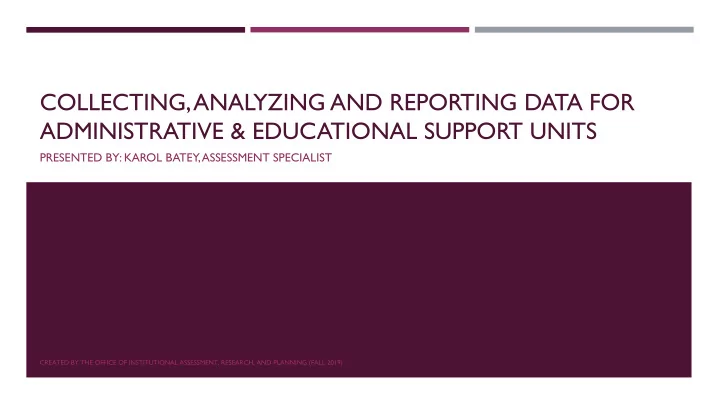

COLLECTING, ANALYZING AND REPORTING DATA FOR ADMINISTRATIVE & EDUCATIONAL SUPPORT UNITS PRESENTED BY: KAROL BATEY, ASSESSMENT SPECIALIST CREATED BY THE OFFICE OF INSTITUTIONAL ASSESSMENT, RESEARCH, AND PLANNING (FALL 2019)
ASSESSMENT PROCESS We have previously learned about the planning stage of the assessment process. Once you have your plan in place now is the time to start our second and third stage of the assessment process. CREATED BY THE OFFICE OF INSTITUTIONAL ASSESSMENT, RESEARCH, AND PLANNING (FALL 2019)
ASSESSMENT PLAN RECAP So far we have: Adopted a mission statement Defined our Goals Developed expected Outcomes and Objectives Decided how we are going to measure those Outcomes Set Targets we want to strive for. Now we have to collect our data defined in our measures. CREATED BY THE OFFICE OF INSTITUTIONAL ASSESSMENT, RESEARCH, AND PLANNING (FALL 2019)
COLLECTION OF ASSESSMENT DATA STAGE TWO CREATED BY THE OFFICE OF INSTITUTIONAL ASSESSMENT, RESEARCH, AND PLANNING (FALL 2019)
WHY DO WE COLLECT DATA? Data can provide credible evidence to show that your program/department/office is successful. It may uncover and address limitations. It helps with internal quality, efficiency, productivity, funding, etc. It shows that you are serious about improving your program/unit/organization. It helps us grow as an institution. CREATED BY THE OFFICE OF INSTITUTIONAL ASSESSMENT, RESEARCH, AND PLANNING (FALL 2019)
WHAT IS DATA COLLECTION? When we write your AES plan, we develop a clear pathway for successful data collection. T o do that we answer these three questions: Where is the data being collected? When should data be collected? Who is collecting the data? CREATED BY THE OFFICE OF INSTITUTIONAL ASSESSMENT, RESEARCH, AND PLANNING (FALL 2019)
HOW DO WE COLLECT DATA? Collecting information about your operation/program. Administration of services/programs. Processes involved in delivering services. Efficiency/progress in meeting timelines/goals. Using your measures to collect good information. Surveys, document records, logs, reports, tests/exams, evaluations, interviews, etc. Organizing data in ways that makes it easier to track, monitor, retrieve, and share. CREATED BY THE OFFICE OF INSTITUTIONAL ASSESSMENT, RESEARCH, AND PLANNING (FALL 2019)
EXAMPLES OF DATA TO COLLECT Reviewing records, reports, archival material, historical data, etc. Conducting surveys, focus groups, interviews. Engaging in direct observations. Simple counting, collecting headcounts, frequencies, rates, percentages, summarizing data, gathering existing statistics, graphs, charts, etc. CREATED BY THE OFFICE OF INSTITUTIONAL ASSESSMENT, RESEARCH, AND PLANNING (FALL 2019)
WHEN IS DATA COLLECTED? As we have already discussed our cycles are one full year long. We can either do Calendar or School year. The data to be collected should correlate with that time period and that time period only. CREATED BY THE OFFICE OF INSTITUTIONAL ASSESSMENT, RESEARCH, AND PLANNING (FALL 2019)
DATA ANALYSIS AND REPORTING STAGE THREE CREATED BY THE OFFICE OF INSTITUTIONAL ASSESSMENT, RESEARCH, AND PLANNING (FALL 2019)
WHAT IS DATA ANALYSIS? Analyze the data to identify what it means for the entity: 1. Could the results be improved? 2. Is the objective and/or measure useful? 3. What are the next efforts that will best contribute to growing CREATED BY THE OFFICE OF INSTITUTIONAL ASSESSMENT, RESEARCH, AND PLANNING (FALL 2019)
DATA ANALYSIS Who analyzes the data? The assessment team who defined the objectives and measures for the assessment plan should reconvene to look at the data. The team should determine by the raw data if the objective’s target level was met, partially met, or not met. You will also need to determine what further action is needed. This is the actual “assessment” part of the assessment process CREATED BY THE OFFICE OF INSTITUTIONAL ASSESSMENT, RESEARCH, AND PLANNING (FALL 2019)
DATA ANALYSIS How do you analyze the data? Analysis should involve asking these questions about the results of each measure: What specifically did your assessments show regarding proven strengths or progress you made on outcomes/objectives? What specifically did your assessments show regarding any outcomes/objectives that will require continued attention? What do you now know about the stated objective and target, in terms of how they will contribute to your unit? Who/what was positively impacted and how? What part of the objective was not met? Why was the target, or why wasn’t the target, achieved? The most important question to ask is how will you use this information to improve your unit? If you can answer that last question, you are ready to proceed in creating your action plan.
REFERENCES Baker, W. (2012). Assessment 101: Non-Academic & Co-Curricular Assessment . http://www.counciloakassessment.com/ Resources , https://elpaso.ttuhsc.edu/oire/Resources.aspx. Shults, Christopher, and Marjorie Dorime-Williams. “Enhancing Administrative, Educational, and Student Support (AES) Assessment: Introducing the SDW Support Outcomes Taxonomy.” York College , https://www.york.cuny.edu/president/institutional-effectiveness/middle-states/enhancing-aes-assessment- introducing-the-sdw-support-outcomes-taxonomy.pdf. CREATED BY THE OFFICE OF INSTITUTIONAL ASSESSMENT, RESEARCH, AND PLANNING (FALL 2019)
Recommend
More recommend